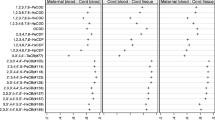Abstract
Pregnant rats were given a small dose of 14C-2,4,5,2′,4′,5′-hexachloro-biphenyl (HCB) and 3H-DDT intraperitoneally. The transfer of HCB and DDT through the placenta and milk was then investigated. Transfer through the placenta was 2.7 and 1.5% (respectively) of the initial doses; transfer through milk was 39.2 and 21.5%. HCB is obviously more transferable than DDT through the placenta and milk, the ratio of the amount of HCB transferred through milk to the amount transferred through the placenta agrees with that for DDT.
Concentrations of HCB and DDT in the whole suckling rat increases rapidly and is similar to the sigmoidal growth curve and change in lipid concentration. Therefore, the concentrations of the chemicals in the maternal tissue generally decrease in comparison with those of nonpregnant rats.
Similar content being viewed by others
References
Ando, M.: Effects of cadmium on the metabolism of DDT (2,2,-bis-(p-chlorophenyl),1,1,1-trichloro-ethane) in rats. Environ. Res., in press
Bragdon, J. H.: Determination of total serum lipids. In: Lipids and steroid hormones in clinical medicine (F.W. Sunderman, F. W. Sunderman, Jr., eds.),pp. 9–14. Philadelphia: J. B. Lippincott 1960
Brown, J. R., Chow, L. I.: Comparative study of DDT and its derivatives in human blood samples in Norfolk Country and Holland Marsh, Ontario. Bull. Environ. Contam. Toxicol. 13, 483–488 (1975)
Curley, A., Copeland, M. F., Kimbrough, R. D.: Chlorinated hydrocarbon insecticides in organs of stillborn and blood of newborn babies. Arch. Environ. Health 19, 628–632 (1969)
Dale, W. E., Gaines, T. B., Hayes, W. J., Jr.: Storage and excretion of DDT in starved rats. Toxicol. Appl. Pharmacol. 4, 89–106 (1962)
Dale, W. E., Miles, J. W., Gaines, T. B.: Quantative method for determination of DDT and DDT metabolites in blood serum. J. Assoc. Off. Anal. Chem. 53, 1287–1292 (1970)
Fries, G. F., Marrow, G. S., Jr., Gordon, C. H.: Long-term studies of residue retention and excretion by cows fed a polychlorinated biphenyl (Arochlor 1254). J. Agric. Food Chem. 21, 117–121 (1973)
Harrison, D. L., Mol, J. C. M.: Transfer of DDT and lindane from ewe to lamb. Proc. 21st N. Z. Weed and Pest Control Conf., pp. 233–239 (1968)
Hart, L. G., Fout, J. R.: Further studies on the stimulation of hepatic microsomal drug metabolism in the rat. Proc. Soc. Exp. Biol. Med. 114, 388–392 (1965)
Hayes, W. J., Jr.: Toxicology of pesticides. Baltimore: Williams and Wilkins 1975
Jansson, B., Jensen, S., Olsson, M., Renberg, L., Sundström, G., Vaz, R.: Identification by GC-MS of phenolic metabolites of PCB and p,p′-DDE isolated from Baltic guillemot and seal. Ambio 4, 93–97 (1975)
Jensen, S., Johnels, A. G., Olsson, M., Otterlind, G.: DDT and PCB in herring and cod from the Baltic, the Kattegat and the Skagerrak. Ambio special report 1, 71–85 (1972)
Jensen, S.: The PCB story. Ambio 1, 123–131 (1972)
Jensen, S., Sunderström, G.: Structures and levels of most chlorobiphenyls in two technical PCB products and in human adipose tissue. Ambio 3, 70–76 (1974)
Kimbrough, R. D., Gaines, T. B., Linder, R. E.: The ultrastructure of livers of rats fed DDT and dieldrin. Arch. Environ. Health 22, 460–467 (1971)
Kodama, H., Ota, H.: Studies on the transfer of PCB to infants from their mothers (1) (in Japanese). Jpn. J. Hyg. 32, 567–573 (1977)
Kuratsune, M., Yoshimura, T., Matsuzaka, J., Yamaguchi, A.: Yusho, a poisoning caused by rice oil contaminated with polychlorinated biphenyls. HSMHA Health Rep. 86, 1083–1091 (1971)
Lambert, G., Brodeur, J.: Influence of starvation and hepatic microsomal enzyme induction on the mobilization of DDT residue in rats. Toxicol. Appl. Pharmacol. 36, 111–120 (1976)
Laug, E. P., Nelson, A. A., Fitzhugh, O. G., Kanze, F. M.: Liver cell alteration and DDT storage in the fat of the rat induced dietary levels of 1 to 50 ppm DDT. J. Pharmacol. Exp. Ther. 98, 268–273 (1950)
Masuda, Y., Kagawa, R., Kuratsune: Comparison of polychlorinated biphenyls in Yusho patients and ordinary persons. Bull. Environ. Contam. Toxicol. 11, 213–216 (1974)
Peterson, R. E., Seymour, J. L., Allen, J. R.: Distribution and biliary excretion of polychlorinated biphenyls in rats. Toxicol. Appl. Pharmacol. 38, 609–619 (1976)
Takagi, Y., Otake, T., Kataoka, Y., Murata, S., Aburada, S., Akasaka, S., Hashimoto, K., Uda, H., Kitamura, T.: Studies on the transfer and distribution of 14C-polychlorinated biphenyls from maternal to fetal and suckling rats. Toxicol. Appl. Pharmacol. 38, 549–558
Author information
Authors and Affiliations
Rights and permissions
About this article
Cite this article
Ando, M. Transfer of 2,4,5,2′,4′,5′-hexachlorobiphenyl and 2,2-bis-(p-chlorophenyl),1,1,1-trichloroethane (p,p′-DDT) from maternal to newborn and suckling rats. Arch. Toxicol. 41, 179–186 (1978). https://doi.org/10.1007/BF00354089
Received:
Issue Date:
DOI: https://doi.org/10.1007/BF00354089




